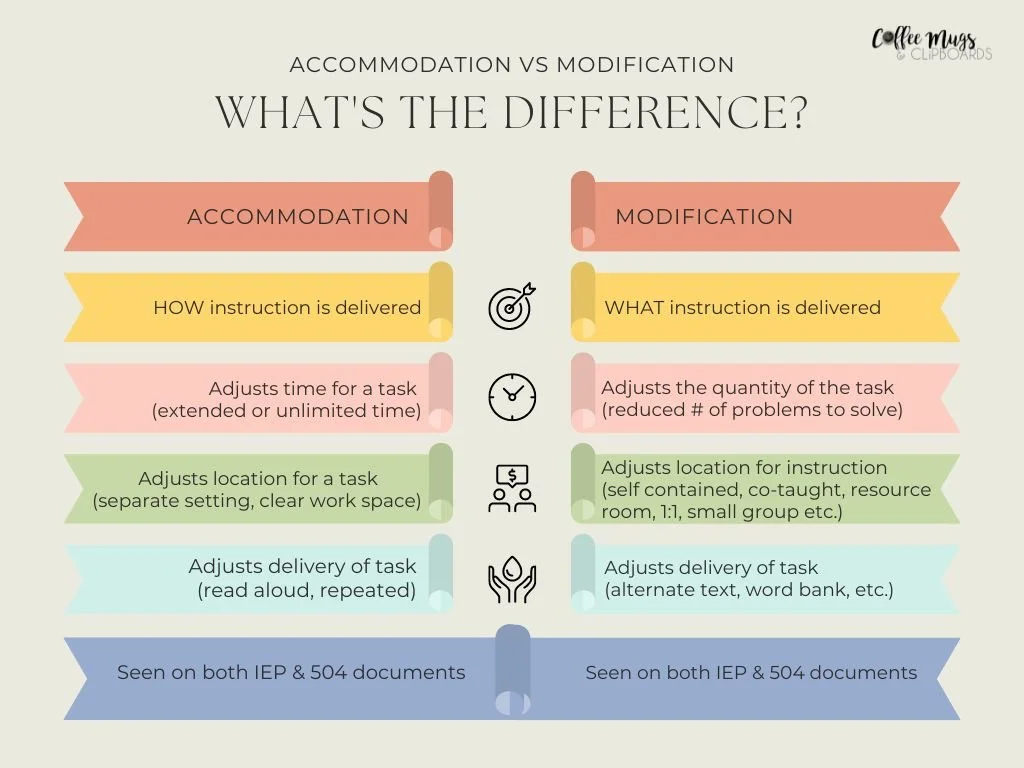Accommodations vs. Modifications
Hi there! How are you? It’s so nice to see you here!
We’ve been “cookin’ up a storm” at Coffee Mugs & Clipboards with our batch of Special Education “Alphabet Soup.” It’s time to add our next ingredient - Accommodations & Modifications.
As a special educator, I’ve been asked countless times both in and out of IEP meetings - “What’s the difference anyway?” So, let’s break it down!
Before we begin, it is important to point out that accommodations and modifications support a learner with an identified disability and are included in both IEP and 504 documents. While this isn’t a discussion on IEP and 504, let’s take a look at both.
504 vs. IEP?
504 documents provide individualized supports that can either adjust how information is delivered to the student or what type of information is being delivered to the student.
IEP documents provide the same supports as a 504 plan, but an IEP includes specific goals and objectives with individualized instruction on targeted areas that the learner has demonstrated a need based on assessment results, observations, etc.
Accommodation vs. Modification
So, what’s the difference anyway?
Accommodation: Adjusts HOW the learner is being delivered instruction
Modification: Adjusts WHAT type of instruction is being delivered to the learner.
Accommodation vs. Modification (Home Edition)
So how do we connect this at home?
Start by looking at your learner’s IEP or 504 document. Supports provided at school can easily be provided at home with simple tweaks.
Below is a continued list of accommodations & modifications (in no particular order) and ways they can be provided at home in your day-to-day routines:
Accommodations:
Visual Schedule - (handwashing, toileting unpacking backpack, etc.)
Calculator - A traditional, computer or cellphone calculator to solve equations on the go.
Word Prediction Software (while typing) - It can be enabled on your cellphone, Google Docs, etc.
Audio Book - Available on Audible, Spotify, etc. Text-to-speech can also be enabled on cellphones and computers too!
Reading a homework problem aloud - If completing on the computer, you can enable text-to-speech or you can read it aloud for your learner
Reward Systems - Token boards, sticker charts, etc. Any system that provides positive reinforcement and earning. Can be posted in a central location in your home (i.e. refrigerator, mud room, wall in the hallway.)
Graphic Organizers, Concrete Examples/Models - Provide systems for the learner that are concrete and label exactly what you are looking for them to do.
Set of school textbooks at home - Make the textbooks easily accessible and in a spot in the home where the learner is most likely to access them for completing assignments.
Planner/Agenda - Can be a paper calendar on the fridge, a weekly calendar you make with post-it notes, or a large white board style family calendar. This is to work on time management and remembering important dates/upcoming information.
Extra Time - When making transitions or completing chores, provide additional time for completion either between the tasks or in completing the entirety of the task.
Pacing/Chunking Long Term Assignments/Projects - This looks back at the planner & agenda. If you have family projects, a birthday party you need to get a present for or a vacation coming up, talk with your family about how to break down the bigger task using chaining. Get a piece of paper and at the top write down the name of the task. You can either do forwards or backwards chaining to write down all of the steps you would need to complete the task, together, as a family.
Spell Check - Enable this feature on your cell phone, google account & more.
Text in a larger print size - Increase the size of your text on your computer screen by zooming in. You can also do this on any cellphone or technology device by enabling under the accessibility features.
To-Do list - Low tech or high tech; this can be written on the refrigerator with a white board or paper list or it can be done on “Keep” with Google.
Modifications:
Completing homework together and walking the learner through solving the task.
( Just an aside - when submitting homework done together, it’s helpful to let the teacher know on post-it note or on the back how long it took the student as well as how much support you provided to continue that home/school communication!)Reduced Homework - When completing tasks at home, focus on presenting 1 - 2 tasks at a time or cut down the number of steps needed for completion such as with chores around the house.
Word Bank - Offer different choices and means for responding.
Can you see yourself using any of these supports at home? What ways will you being to incorporate them for your learner?
Be sure to share with me over on Instagram @coffemugsandclipboards!
I’m so glad you’re here!



